Siguiendo a Crowdstar: cómo un estudio rompió el libro de reglas de juego de 'la mujer primero'
Esta publicación es coautora de Adam Telfer y Michail Katkoff de Deconstructor Of Fun .
Desde que Facebook adoptó por completo el juego gratuito, Crowdstar y otros se han esforzado por familiarizarse con lo que tal vez se ha denominado de manera más bien burda el juego "femenino primero", para hacerse un nombre como una empresa que realmente comprende y cumple con un grupo demográfico desatendido. en el mercado.
En la práctica, esto se tradujo en, al menos inicialmente, una serie de juegos de estilo “lindo”; cuidar de dulces animales, administrar una granja llena de animales de granja con ojos enormes o vestir juegos con demasiado brillo y rosa por todas partes. Terminó con un estudio creando juegos para un estereotipo: una visión ficticia y demasiado simplista de lo que podría interesar a las mujeres, con muy poca comprensión de los matices que el grupo demográfico elegido realmente quería.
Peor aún, no muchos desarrolladores lograron ir mucho más allá, creyendo que centrar un título en animales lindos con ojos grandes era la forma de hacer que un juego fuera "amigable para las mujeres".
Crowdstar desafió esa suposición con la creación de los juegos Covet Fashion y Design Home, y valió la pena. El juego es uno de los primeros de su tipo en crear verdaderamente un híbrido de juego de red social que recrea la sensación de ser un profesional en diseño de moda y decoración de interiores. También es uno de los pocos juegos que realmente cumple con las profesiones reales de diseño de interiores o moda sin sentirse cursi.
No solo eso, Crowdstar ha logrado ofrecer un bucle central sólido construido alrededor de principios igualmente sólidos de excelente diseño F2P: un bucle central que, me atrevo a decir, nunca antes se había visto en la App Store. Entonces, ¿por qué tuvo tanto éxito?
Una breve historia de Glu y Crowdstar
Crowdstar se fundó en 2008, centrándose primero en títulos gratuitos para Facebook Canvas antes de pasar a los dispositivos móviles en 2012. Crowdstar recaudó inicialmente una Serie A de 23 millones de dólares en mayo de 2011 gracias al éxito de la empresa en Facebook, recaudando una ronda adicional de 11 millones de dólares en mayo de 2012 para financiar un giro hacia la telefonía móvil.

La compañía siempre se ha centrado en los primeros juegos femeninos, empezando por los juegos basados en el cuidado de animales en Facebook (Happy Aquarium, Fish with Attitude) antes de pasar finalmente a la moda y ahora, finalmente, a la decoración de interiores.

fuente: AppAnnie
Covet Fashion se lanzó en 2013 y se ha mantenido dentro del Top 200 de recaudación desde su lanzamiento, aunque ha experimentado un declive lento y constante desde el otoño de 2016. Design Home se lanzó durante este período y se ha mantenido dentro del Top 100 de recaudación desde su lanzamiento, a pesar de tener un conjunto de características más pequeño en comparación con Covet Fashion. Al ofrecer estos juegos, Crowdstar se consolidó como uno de los principales desarrolladores, captando la atención de los jugadores más importantes de la App Store.

fuente: PocketGamer.biz
Como resultado, Glu adquirió una participación mayoritaria en Crowdstar justo antes del lanzamiento de Design Home en 2016, principalmente debido a la disminución de Glu en sus juegos de estilo estrellato IP de celebridades con licencia: Kim Kardashian: Hollywood y Katy Perry Pop, algunos de los más notables. La red de jugadores de Glu de su red de juegos de estrella era una sólida plataforma de promoción cruzada para los juegos de Crowdstar, lo que la convertía en una adquisición claramente mejor que la suma de sus partes. Crowdstar ahora tiene el control dominante de la audiencia de la red de decoradores de interiores y moda, junto con la fortaleza de Glu en marketing, análisis, UA y experiencia en operaciones en vivo.
Bucle central

El circuito central de Design Home es sencillo. Los jugadores participan en desafíos cronometrados que les piden diseñar espacios con ciertos requisitos.
- El jugador selecciona un desafío de una lista
- Completa el desafío de diseño seleccionando muebles de su colección personal.
- Envíe su desafío y espere a que otros jugadores lo voten. Las recompensas se basan en qué tan bien calificó la comunidad su creación.
- Para comenzar la próxima competición, el jugador debe recoger llaves. Las claves se obtienen votando las creaciones de otros jugadores.
Analicemos cada paso con un poco más de detalle:
Paso 1: seleccionar un desafío
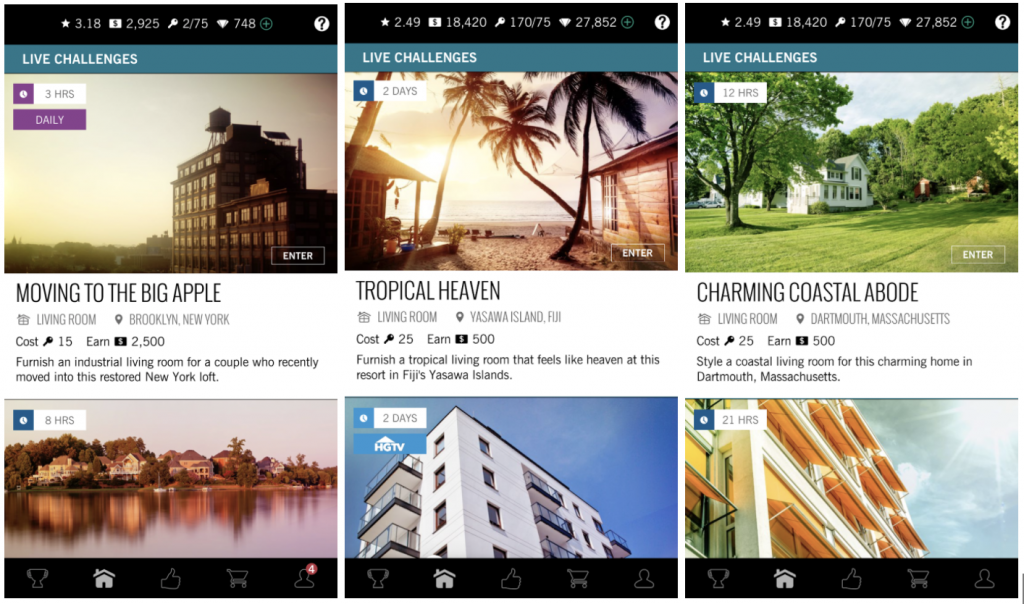
El núcleo del juego consiste en seleccionar de una lista de eventos de tiempo limitado, que desafían al jugador a diseñar para un estilo de hogar específico. Por ejemplo, el evento "Tropical Heaven" requiere que los jugadores amueblen una sala de estar tropical para que "se sienta como el paraíso" en un resort en las Islas Yasawa de Fiji.
Los eventos pueden realizarse en cualquier lugar del mundo, con requisitos muy diferentes de un evento a otro. Algunos eventos pueden ser “eventos diarios clave”, mientras que otros pueden incluirse como parte de eventos estacionales temáticos más amplios. Por ejemplo, el juego fue sede de un evento para el canal de televisión de mejoras para el hogar HGTV. Como parte del acuerdo, los jugadores podrían participar en competencias “temáticas de HGTV” y contar sus respectivos puntajes allí.
Cuando un jugador ha seleccionado un evento en el que quiere participar, paga la tarifa de inscripción (en este caso, las llaves) y luego comienza a diseñar.
Paso 2: Diseñar
Después de que un jugador ha seleccionado su desafío, se le da un breve resumen ficticio antes de ingresar a una habitación sin muebles ni decoraciones. Todos, excepto los desafíos diarios, vienen con requisitos únicos, como muebles de cierto estilo o color.
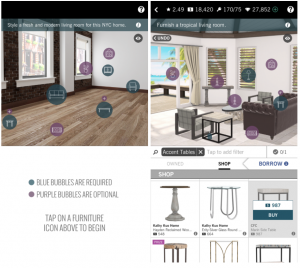
Each Challenge is a room filled with two kinds of ‘spots’: one spot where the player is required to fill with certain type of items, and a second spot ones where what they can place is optional. Player can’t change the colors of the wall or move the spots where items are placed, meaning play takes the form of a very simple placement puzzle that limits the creativity but also makes it easy for anyone to complete a Challenge.
Players can place items they own as well as pieces that they don’t own. If a player doesn’t have the necessary items, they can purchase or borrow them on-the-spot to fulfill requirements or make the room come together. After all of the required items have been placed, player submits the Challenge for other players to review. Submitting the Challenge rewards player immediately with Coins and XP.
It’s important to notice that once player has submitted their Challenge, they also lose the ability to use those items in other challenges until the submitted Challenge is over. This forces player to have bigger collections and multiples of the same item.
Step 3: Waiting for Results
After a player has completed their Challenge, they receive a Cash and XP reward. However, this is just the base reward. They need to wait for all other players to vote on their creation to get a final rating.
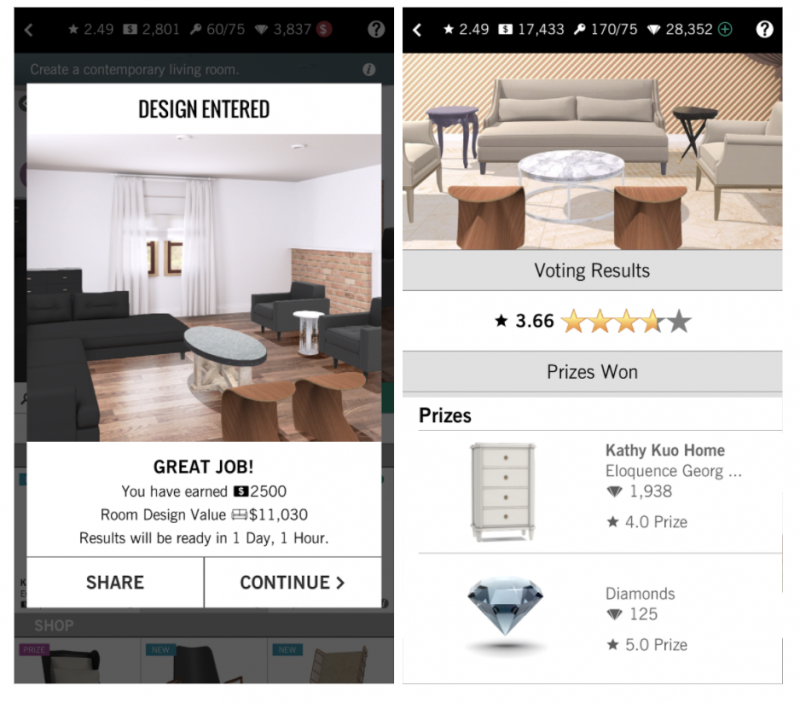 After the voting time is over, a player also receives a bonus reward based on how their design was perceived by the community. The verdict comes in form of a five star rating and if a player exceeds four stars, they will receive a piece of furniture as a reward.
After the voting time is over, a player also receives a bonus reward based on how their design was perceived by the community. The verdict comes in form of a five star rating and if a player exceeds four stars, they will receive a piece of furniture as a reward.
Step 4: Vote to Earn Keys
Pacing in Design Home is handled partially through Keys – Keys that, quite literally, unlock events. Each time a player votes for a few other player’s designs, they are given keys, with five votes awarding three keys. In practice that means a player needs to vote on 45 different designs in order to enter a Challenge.
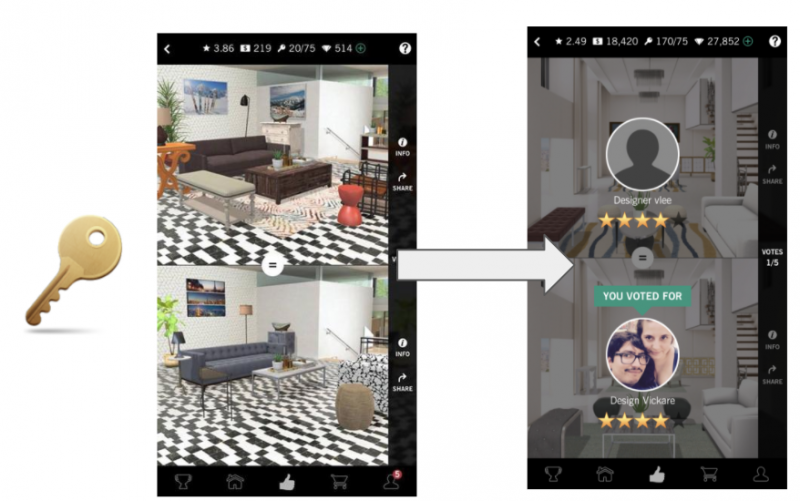
This forces players to not only be a part of the design creation, but also encourages them to constantly vote and legitimize the ratings they receive.
Besides keys, players are also paced by their collection of furniture. Each piece of furniture they purchase has a limit of one to three pieces, so players with smaller collections can’t enter in as many competitions. Also players are incentivized to have a wider collection of pieces, since using up all your best furniture in one event is not wise.
3 Keys to Design Home’s Success
#1: Events at the Core
The first key reason for Design Home’s success is the way that their core gameplay is wrapped around constantly changing events.
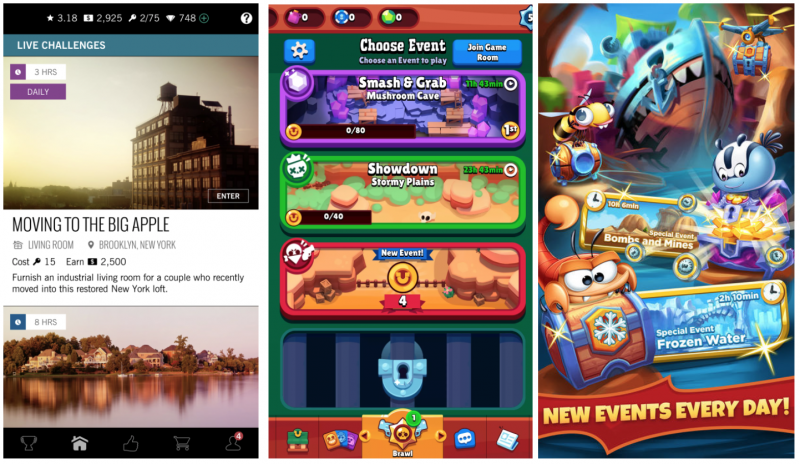
This is a design that’s now being replicated outside of Crowdstar’s lineup. Finnish giant Supercell used a similar design in Brawl Stars, while Seriously used a similar design in their upcoming game Best Fiends Rivals. Like Crowdstar, they’ve all realised it’s a great way to create a constantly changing core.
Why it’s so effective:
- The game almost simulates the social media ‘feeds’ of the likes of Facebook and Instagram, making the player feels like there’s always be something new, something interesting going on with the game. It’s a strategy that pulls the player back throughout the day to see what new modes, what new events are happening
- This gives the developer an easy way to change up the gameplay over time through live ops; introduce new modes, limited time events, to drive interesting changes to the game. This is the key to long term retention. Events are increasingly the most important feature within a game which can make all the difference when the game is live. As reported in the “Toon blast” article, competitive events which change up the core slightly and add variety are proven to drive engagement and revenue. It can turn a good game into a great game
#2: Monetizing On Emotion
Design Home doesn’t follow a lot of recent trends in monetization. It doesn’t have gacha, it doesn’t use a lot of timers, it doesn’t even allow players to skip the voting timers to get their rewards early. So, just how does it succeed?
Crowdstar monetizes from two key systems; slowly pushing players to care about their overall rating, and creating an emotional connection to what you’re creating. As a result, they monetize like no one else does.
The base of monetization in Design Home is the slowing of progress – specifically the overall score of the players’ accounts. After each event, your voting results impact what your account’s overall score is. In short, to increase your score, you need to get great results.
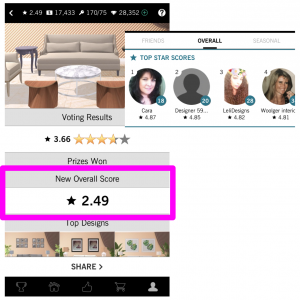
Design Home’s rating algorithm is set up in a way such that the voting results ratings typically fall between 3.0 and 5.0 rating. Getting lower than 3.5 rating seems to be a very rare occurrence. To begin with, your account’s overall score is 2.0. So, as a player first joins, each result from voting is guaranteed to make major progress to their review score.
When a player reaches a 3.5+ rating, this progress significantly slows down. In order to reach a 4+ rating they need to be consistently getting a voter rating of over 4. This requires a large collection of furniture alongside a sense of what will rate highest in a given event.
As a player hits this 4+ tipping point, their progress significantly slows once more and the easiest way to make progress is to buy the newest, best valued furniture equipment.
In short, Crowdstar has created a system where players actively care about their overall score, and so only want to submit designs that will increase it. As a result, the second major monetization point comes from the just-in-time purchasing of items and emotional connection.

On this emotional score, each player lives out the fantasy of being a Interior Decorator in play. When decorating a room, the motivation stems from creating the space they envision will win the competition. However, especially early in the game, they have very limited access to the most desirable furniture.
This is where the “just-in-time” purchasing is impactful. Players can preview how amazing a new piece of furniture would look in their design, and purchasing with Cash or Diamonds is just a quick tap away.
As the player progresses, inevitably they will need to grind for major resources. Cash and Diamonds will become strapped as they progress due to how expensive the furniture is and how low each competition pays out. So over time, players will have to decide if they grind events by putting any possible furniture into it – wait a long time for their furniture to return to their collection – or spend.
Crowdstar really preys on the player’s internal drive to create only great things. No one wants to feel like they are submitting a design to a social competition that is sub par, especially when your Facebook profile associated with it.
The key learning here is, players are willing to spend both to maximize their chance of a high rating and because no one likes submitting something that they aren’t proud of.
By combining these two systems, Crowdstar has created the perfect storm – it’s whipped up a great way to monetize off players purchasing decorations directly, which is a system that no other developer in the top grossing uses to this degree.
#3: Professional Visuals Real-Life Brands
Lastly, what key aspect I believe that drove the success of Covet Fashion and Design Home is that these games aren’t designed to look like a usual cutesy free to play game – they are styled like a professionally designed app.
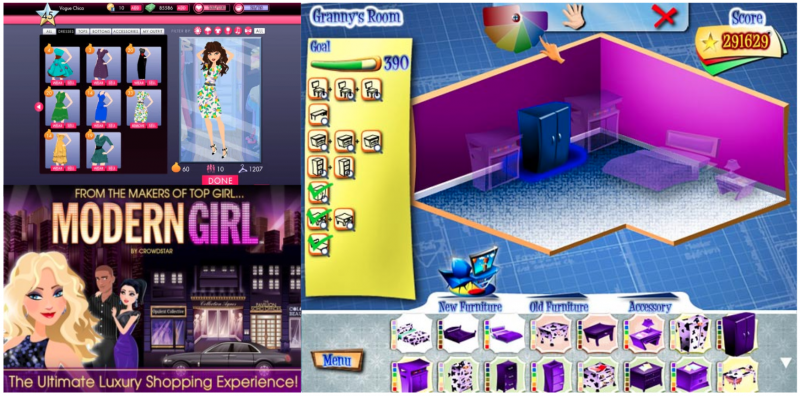
If you look at many of the Fashion Styling and Interior Decorating games created before it, they all resembled over the top pink, cartoony, and pretty gaudy color selection. Design Home’s look and feel is closer to a furniture magazine or professional software for interior decorating compared to a game. This both reinforces the fantasy and I believe strikes a chord with the audience – it’s a game for mature designers, not for kids.

Of course what really ties this all together is the use of brands within the game it’s a win-win situation for both Crowdstar and the brands involved. Design Home is seen as a professional designing game by the game’s audience – a game where players get to place real furniture that they could feasibly buy in real life, and can even within the app.
Además de esto, las marcas obtienen exposición dentro de la aplicación a su público objetivo: personas que aman los muebles de diseño. Marcas como HGTV patrocinan eventos y las marcas de muebles pueden pagarle a Crowdstar para aumentar el rango de clasificación de los muebles que ponen en juego. Las marcas pueden incluso pagarle a Crowdstar para que tenga eventos "exclusivos de marca", por ejemplo. uno donde solo se permiten muebles "Blink Home".
Conclusiones
Design Home y Covet Fashion son juegos clave para Glu + Crowdstar. La compañía ha creado un híbrido exitoso de red social y juego, y ha ofrecido un entorno PvP competitivo para un mercado tradicionalmente reducido a la competencia: la moda y la decoración de interiores. Crea una fuerte retención a largo plazo y muchas salidas para que Crowdstar + Glu pueda aprovecharlas en los años venideros.
Mis claves para su éxito:
- Bucle central impulsado por eventos que brinda suficiente variedad para que las colecciones de los jugadores sean desafiadas constantemente y le brinda a Crowdstar una salida para crear eventos de tiempo limitado y nuevas competencias interesantes para impulsar el juego a largo plazo.
- El bucle central monetiza fuertemente las emociones clave de los jugadores : que quieren llegar a la cima de la clasificación creando los mejores diseños posibles + que nunca quieren publicar nada que no crean que es de calidad.
- Que el juego está diseñado como una aplicación de diseño profesional y no como un juego cursi . Este es un juego que entiende completamente su mercado.
Leave a Reply